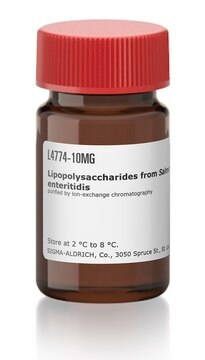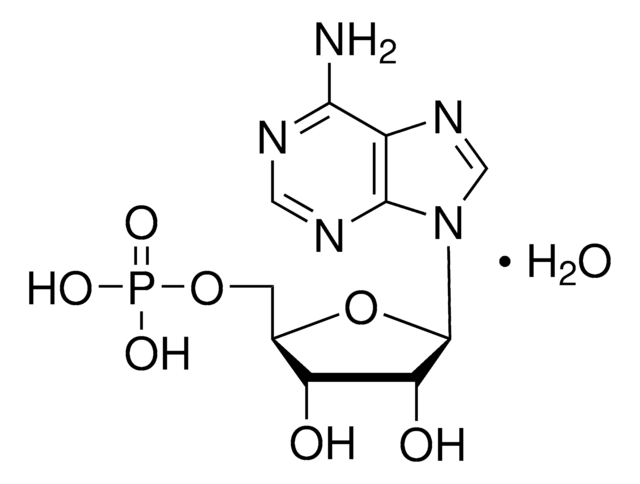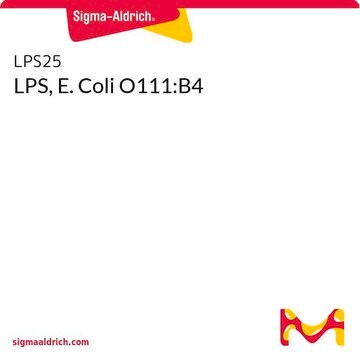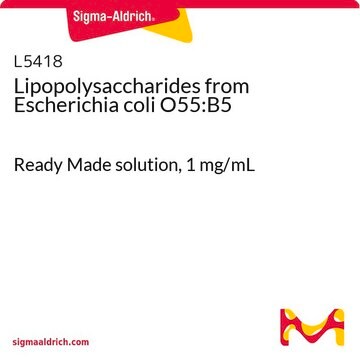T3382
Lipopolysaccharides from Escherichia coli O111:B4
trinitrophenyl conjugate
Synonym(s):
LPS
Sign Into View Organizational & Contract Pricing
All Photos(1)
About This Item
Recommended Products
biological source
Escherichia coli (O111:B4)
conjugate
trinitrophenyl conjugate
form
lyophilized powder
extent of labeling
10-60 μg trinitrophenol per mg LPS
shipped in
ambient
storage temp.
2-8°C
Looking for similar products? Visit Product Comparison Guide
Application
Lipopolysaccharides (LPSs) are characteristic components of the cell wall of Gram-negative bacteria. LPS and its lipid A moiety stimulate cells of the innate immune system by the Toll-like receptor 4 (TLR4), a member of the Toll-like receptor protein family, which recognizes common pathogen-associated molecular-patterns (PAMPs).
Signal Word
Danger
Hazard Statements
Precautionary Statements
Hazard Classifications
Acute Tox. 2 Oral
Storage Class Code
6.1A - Combustible acute toxic Cat. 1 and 2 / very toxic hazardous materials
WGK
WGK 3
Flash Point(F)
Not applicable
Flash Point(C)
Not applicable
Personal Protective Equipment
dust mask type N95 (US), Eyeshields, Gloves
Choose from one of the most recent versions:
Already Own This Product?
Find documentation for the products that you have recently purchased in the Document Library.
Customers Also Viewed
Thiago Alves Teixeira dos Santos et al.
PloS one, 6(11), e27867-e27867 (2011-12-06)
Phosphatidylserine (PS) exposure on the cell surface indicates apoptosis, but has also been related to evasion mechanisms of parasites, a concept known as apoptotic mimicry. Toxoplasma gondii mimics apoptotic cells by exposing PS, inducing secretion of TGF-beta1 by infected activated
Elisabeth G Vichaya et al.
Brain, behavior, and immunity, 23(7), 969-976 (2009-05-14)
Recent research indicates that glial cells control complex functions within the nervous system. For example, it has been shown that glial cells contribute to the development of pathological pain, the process of long-term potentiation, and the formation of memories. These
Marcus Mühlbauer et al.
Immunology, 124(2), 256-264 (2008-02-21)
Epididymitis represents a serious threat to male fertility and usually develops following secondary bacterial infection of the epididymis such as urinary tract infections or sexually transmitted diseases. Surprisingly, very little is known about the innate host response triggered by bacterial
Katherine E Wickliffe et al.
Cellular microbiology, 10(6), 1352-1362 (2008-02-13)
Macrophages from certain inbred mouse strains are rapidly killed (< 90 min) by anthrax lethal toxin (LT). LT cleaves cytoplasmic MEK proteins at 20 min and induces caspase-1 activation in sensitive macrophages at 50-60 min, but the mechanism of LT-induced
Amanda M Enstrom et al.
Brain, behavior, and immunity, 24(1), 64-71 (2009-08-12)
Autism spectrum disorders (ASD) are characterized by impairment in social interactions, communication deficits, and restricted repetitive interests and behaviors. Recent evidence has suggested that impairments of innate immunity may play an important role in ASD. To test this hypothesis, we
Our team of scientists has experience in all areas of research including Life Science, Material Science, Chemical Synthesis, Chromatography, Analytical and many others.
Contact Technical Service






